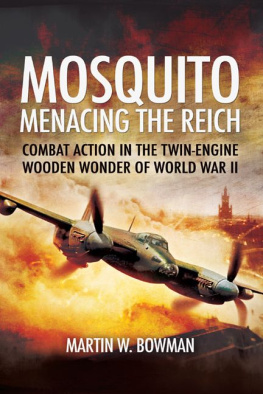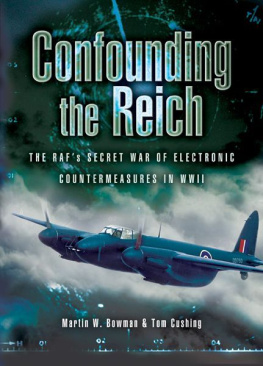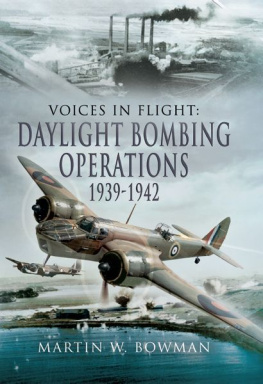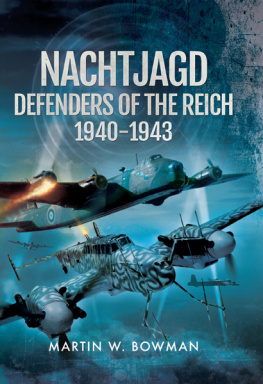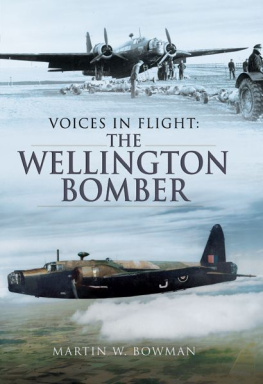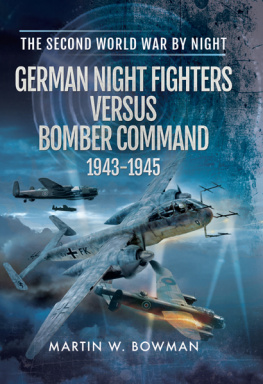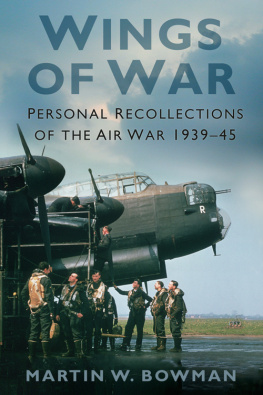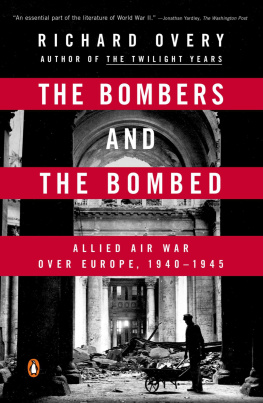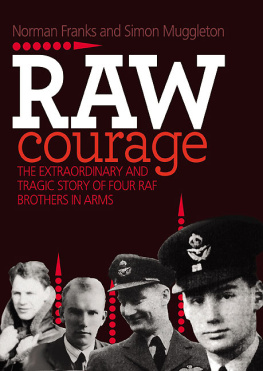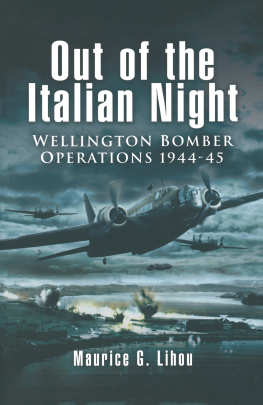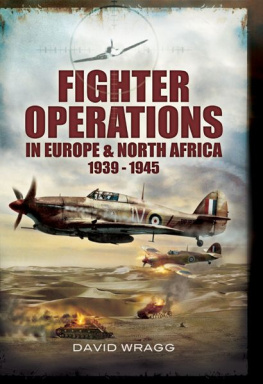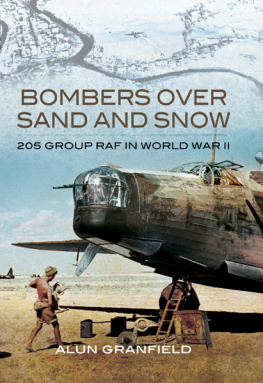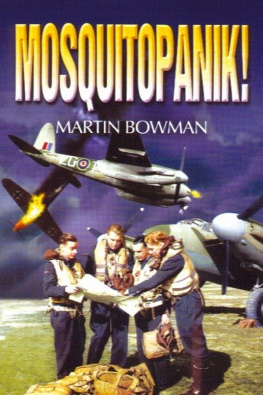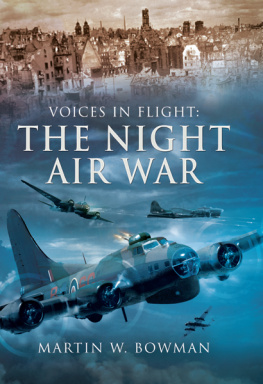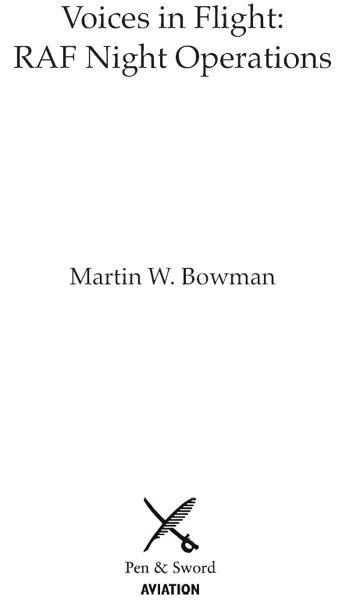
First Published in Great Britain in 2015 by
Pen & Sword Aviation
an imprint of
Pen & Sword Books Ltd
47 Church Street, Barnsley, South Yorkshire S70 2AS
Copyright Martin W Bowman, 2015
ISBN: 9781783831944
EPUB ISBN: 9781473860797
PRC ISBN: 9781473860780
The right of Martin W Bowman to be identified as author of this work
has been asserted by him in accordance with the
Copyright, Designs and Patents Act 1988.
A CIP catalogue record for this book is
available from the British Library.
All rights reserved. No part of this book may be reproduced or transmitted in
any form or by any means, electronic or mechanical including photocopying,
recording or by any information storage and retrieval system, without
permission from the Publisher in writing.
Typeset in 10/12pt Palatino
by GMS Enterprises PE3 8QQ
Printed and bound in England by
CPI Group (UK) Ltd, Croydon, CR0 4YY
Pen & Sword Books Ltd incorporates the Imprints of Pen & Sword
Aviation, Pen & Sword Family History, Pen & Sword Maritime, Pen & Sword
Military, Pen & Sword Discovery, Wharncliffe Local History, Wharncliffe
True Crime, Wharncliffe Transport, Pen & Sword Select, Pen & Sword
Military Classics, Leo Cooper, The Praetorian Press, Remember When,
Seaforth Publishing and Frontline Publishing.
For a complete list of Pen & Sword titles please contact
PEN & SWORD BOOKS LIMITED
47 Church Street, Barnsley, South Yorkshire, S70 2AS, England
E-mail:
Website: www.pen-and-sword.co.uk
Contents
Acknowledgements
I am indebted to all the contributors for their words and photographs, in particular Nora Norgate; Jim Moore DFC and The 49 Squadron Association.
Thanks also go to my fellow author, friend and colleague, Graham Simons, for getting the book to press ready standard and for his detailed work on the photographs; to Pen & Sword and in particular, Laura Hirst; and Jon Wilkinson, for his unique jacket design once again.
Prologue
Ghost Fighters Over Dunkirk
D. H. Clarke DFC AFC
In those fateful few days at the end of May and beginning of June 1940 when the British Expeditionary Force lay crammed on the Dunkirk beaches entirely at the mercy of the German Army, Britain could have lost the war. That she did not was due to German lack of foresight and the tremendous efforts made to save the men on the beaches. The soldiers, huddled together on the shell-strafed beaches, were well aware of the efforts being made when they saw the shoals of boats, naval and civilian, queuing to take them off. But, as they were strafed time and time again by enemy aircraft, the cry went up Wheres the RAF?
The fact that the RAF were at Dunkirk and played a leading role in the success of the operation is now part of history, although, perhaps, their part was not obvious to the men on the beaches. But I was there too, flying through the misty vastness of the night skies. And if my own aircraft could not be seen by the men below, at least I was in a position to know what happened to the pilots who flew in the daytime.
Despite the fact that Dowding was anxious to husband his front line fighters for what was to be called the Battle of Britain, Group alone maintained average of fifteen Hurricane Squadrons over Dunkirk. But there were also other types capable of carrying guns and it makes not a jot of difference if most of them were antiquated, obsolete or totally unsuitable for the task. These aircraft flew over Dunkirk, apparently unrecognised by our troops - so that in retrospect it seems as if I flew with ghosts.
I operated from Detling, a small aerodrome on the escarpment near Maidstone and normally used by one squadron of Ansons only. I flew there in a yellow and black striped target-towing Blackburn Skua from my base at Gosport on the evening of 31 May 1940 and in company with me was a similarly painted Fairey Battle, also equipped with a D-type winch for target towing and piloted by Pilot Officer Cliff Rendle. In the two aircraft we carried our winch operators. LACs Phelan and Verrier, Sergeant Jefferies as general handyman and Flight Lieutenant Digger Aitken, who was in charge of our little unit. Digger was a regular officer, but Cliff, like myself, held a four-year short service commission. Although I was senior to him by a few months, we had roughly the same amount of hours in our log-books - about 400 - but neither of us had more than two hours night-flying experience. Our total operational experience was nil, so although we were rather surprised at the strange assortment of aircraft which were parked on the aerodrome - Ansons, Battles, a Gauntlet, Vildebeeste, Lysanders, an old Harrow, Swordfish and several other oddments - we certainly did not think of them, or of ourselves as front line fighters.
We asked the way to the Navigation Room and there we found a confusion of pilots and aircrew. Struggling through the crowd, we eventually located the Station CO to whom we had been ordered to report. Group Captain Sainsbury was middle-aged, large and florid: his desk represented an oasis of calm in the surrounding tumult. Digger introduced us and we saluted. I understand that one of you has been shown the flares this afternoon, the Group Captain said. I was startled. It was true that I had been told to fly over to Lee-on-Solent just after lunch to have a look at a new idea for target towing at night, but I couldnt understand how he came to know about it.
Y-yes, sir, I stuttered. It must have been me.
Well, dont you know?
Im sorry, sir. I pulled myself together. I was shown how we could tow lighted flares for night target practice, sir but nothing was said about coming here to do it.
Hm! Night target practice - someone has a sense of humour. Group Captain Sainsbury accepted the joke, if joke it was, without even a flicker of emotion. Then he went on, addressing us all.
You are no doubt aware that the British Expeditionary Force has retreated to the French port of Dunkirk just across the Channel - here. He turned in his chair and stabbed a finger at a four-miles-to-the-inch map pinned to the wall behind him. You are probably not aware that the Navy are doing their damnedest to rescue as many soldiers as they can from this untenable position. Now, we at Detling are operating a selection of aircraft day and night to give air-cover and your particular job - codenamed Flash - is to illuminate the sea north of the ferry lane so that our bombers can spot any enemy shipping that is around which is likely to interfere with the evacuation.
The sudden impact of the connection between what I had seen demonstrated only a few hours before and what we were expected to do with the flares, made me feel sick - empty sick: a condition which I soon came to recognise as the twitch and something that was inevitable before any operational flight.
The Group Captain continued. You will patrol between Dunkirk and the River Scheldt, about ten miles offshore, lighting your flares one at a time until they are all used. I understand that they burn for 3 minutes, so take as many as you think you can manage in the rear cockpit - about twenty to thirty should do. He paused and looked at me intently - then at Cliff. You realise, of course, that with 20,000 candlepower to light up the sea, you will also light up yourselves. We dont know if the Germans have any night-fighters in the area, but if they have you will be sitting targets. Consequently I cannot allow you to take maps or documents of any sort with you - in fact, before you go I want you to clear out your pockets completely and check that your crew does the same. Your radio sets should have been removed at Gosport (Digger signified that they had), but I would like you to check through your aircraft and make sure that anything which might be of use to the enemy is removed. We cant be too careful.
Next page

